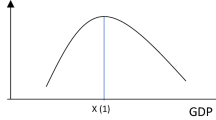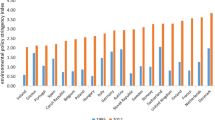Abstract
This paper provides an empirical analysis of the relative impacts of various factors on CO2 emissions from production of goods and services in China during two consecutive periods of 1992–1997 and 1997–2002. Results show that, on the positive side, level of final demand for goods and services was the main reason for the increase of production-source CO2 emission, while structure of net export has similar positive effect during the first period of 1992–1997. On the negative side, technology factors remains as the main factors reducing emissions. The level of net export played some role in the first period, but the effects were seen in the second period from energy intensity, fuel mix and input mix. The results suggest that economic structure be focused as an important factor for CO2 emission reduction, with construction and transport as two key industries to lower carbon emission.
Similar content being viewed by others
References
Caster SD, Rose A (1998) Carbon dioxide emissions in the US economy. Environ Resour Econ 11(3–4): 349–363
Chang YF, Lin SJ (2001) Structural decomposition of CO2 emissions from Taiwan’s petrochemical industries. Energy Policy 29(3): 237–244
Feng XZ, Zou J (2008) Economic analysis of CO2 emission trends in China. China Popul Resour Environ 18(3): 43–47 (in Chinese)
Gowdy JM, Miller JL (1987) Technological and demand change in energy use: an input-output analysis. Environ Plann A 19: 1387–1398
Han X, Lakshmanan TK (1994) Structural changes and energy consumption in the Japanese economy 1975–85: an input–output analysis. Energy J 15: 165–188
Leontiel W, Ford D (1972) Air pollution and the economic structure: empirical results of input–output economics. Input–output techniques, pp 9–30
Lin X, Polenske KR (1995) Input–output anatomy of China’s energy-demand change: 1981–1987. Econ Syst Res 7: 67–84
Metter W (1998) Sources of change in emissions from energy: a structure decomposition analysis. Econ Syst Res 10(2): 99–112
Nobuko Y (2004) An analysis of CO2 emissions of Japanese industries during the period between 1985 and 1995. Energy Policy 32(5): 595–610
Rose A, Chen CY (1991) Sources of change in energy use in the U.S. economy, 1972–1982: a structural decomposition analysis. Resour Energy 13(1): 1–21
Yih FC, Lin SJ (1998) Structural decomposition of industrial CO2 emission in Taiwan: an input–output approach. Energy Policy 26(1): 5–12
Yih FC, Lewisb C, Lin SJ (2008) Comprehensive evaluation of industrial CO2 emission (1989–2004) in Taiwan by input–output structural decomposition. Energy Policy 36(7): 2471–2480
Author information
Authors and Affiliations
Corresponding author
Additional information
Supported by National Natural Science Foundation of China (No. 70903045).
Rights and permissions
About this article
Cite this article
Zhang, H., Qi, Y. A Structure Decomposition Analysis of China’s Production-Source CO2 Emission: 1992–2002. Environ Resource Econ 49, 65–77 (2011). https://doi.org/10.1007/s10640-010-9424-z
Accepted:
Published:
Issue Date:
DOI: https://doi.org/10.1007/s10640-010-9424-z




